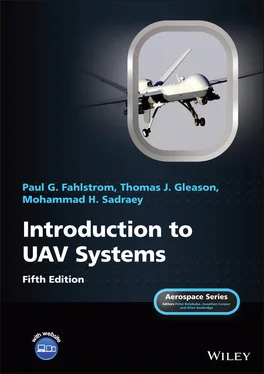1 Cover
2 Series Page
3 Title Page Introduction to UAV Systems Paul Gerin Fahlstrom UAV Manager, US Army Material Command Thomas James Gleason Gleason Research Associates, Inc. Mohammad H. Sadraey Southern New Hampshire University Fifth Edition
4 Copyright Page
5 Dedication Page
6 Preface
7 Series Preface
8 Acknowledgments
9 List of Acronyms
10 About the Companion Website
11 Part I: Introduction 1 History and Overview1.1 Overview 1.2 History 1.3 Overview of UAV Systems 1.4 The Aquila 1.5 Global Hawk 1.6 Predator Family 1.7 Top UAV Manufacturers 1.8 Ethical Concerns of UAVs Questions 2 Classes and Missions of UAVs2.1 Overview 2.2 Classes of UAV Systems 2.3 Examples of UAVs by Size Group 2.4 Expendable UAVs Questions
12 Part II: The Air Vehicle 3 Aerodynamics3.1 Overview 3.2 Aerodynamic Forces 3.3 Mach Number 3.4 Airfoil 3.5 Pressure Distribution 3.6 Drag Polar 3.7 The Real Wing and Airplane 3.8 Induced Drag 3.9 Boundary Layer 3.10 Friction Drag 3.11 Total Air‐Vehicle Drag 3.12 Flapping Wings 3.13 Aerodynamic Efficiency Questions 4 Performance4.1 Overview 4.2 Cruising Flight 4.3 Range 4.4 Endurance 4.5 Climbing Flight 4.6 Gliding Flight 4.7 Launch 4.8 Recovery Questions 5 Flight Stability and Control5.1 Overview 5.2 Trim 5.3 Stability 5.4 Control 6 Propulsion6.1 Overview 6.2 Propulsion Systems Classification 6.3 Thrust Generation 6.4 Powered Lift 6.5 Sources of Power 6.6 Sources of Electric Energy 6.7 Power and Thrust Questions 7 Air Vehicle Structures7.1 Overview 7.2 Structural Members 7.3 Basic Flight Loads 7.4 Dynamic Loads 7.5 Structural Materials 7.6 Composite Materials 7.7 Construction Techniques 7.8 Basic Structural Calculations Questions
13 Part III: Mission Planning and Control 8 Mission Planning and Control Station8.1 Introduction 8.2 MPCS Subsystems 8.3 MPCS Physical Configuration 8.4 MPCS Interfaces 8.5 MPCS Architecture 8.6 Elements of a LAN 8.7 OSI Standard 8.8 Mission Planning 8.9 Pilot‐In‐Command Questions 9 Control of Air Vehicle and Payload9.1 Overview 9.2 Levels of Control 9.3 Remote Piloting the Air Vehicle 9.4 Autopilot 9.5 Sensors Supporting the Autopilot 9.6 Navigation and Target Location 9.7 Controlling Payloads 9.8 Controlling the Mission 9.9 Autonomy Questions
14 Part IV: Payloads 10 Reconnaissance/Surveillance Payloads10.1 Overview 10.2 Imaging Sensors 10.3 Target Detection, Recognition, and Identification 10.4 The Search Process 10.5 Other Considerations Questions 11 Weapon Payloads 11.1 Overview 11.2 History of Lethal Unmanned Aircraft 11.3 Mission Requirements for Armed Utility UAVs 11.4 Design Issues Related to Carriage and Delivery of Weapons 11.5 Signature Reduction 11.6 Autonomy for Weapon Payloads Questions 12 Other Payloads12.1 Overview 12.2 Radar 12.3 Electronic Warfare 12.4 Chemical Detection 12.5 Nuclear Radiation Sensors 12.6 Meteorological and Environmental Sensors 12.7 Pseudo‐Satellites 12.8 Robotic Arm 12.9 Package and Cargo 12.10 Urban Air Mobility Questions
15 Part V: Data Links 13 Data Link Functions and Attributes13.1 Overview 13.2 Background 13.3 Data‐Link Functions 13.4 Desirable Data‐Link Attributes 13.5 System Interface Issues 13.6 Antennas 13.7 Data Link Frequency Questions 14 Data‐Link Margin14.1 Overview 14.2 Sources of Data‐Link Margin 14.3 Anti‐Jam Margin 14.4 Propagation 14.5 Data‐Link Signal‐to‐Noise Budget Questions 15 Data‐Rate Reduction15.1 Overview 15.2 Compression Versus Truncation 15.3 Video Data 15.4 Non‐Video Data 15.5 Location of the Data‐Rate Reduction Function Questions 16 Data‐Link Tradeoffs16.1 Overview 16.2 Basic Tradeoffs 16.3 Pitfalls of “Putting Off” Data‐Link Issues Questions
16 Part VI: Launch and Recovery 17 Launch Systems17.1 Overview 17.2 Conventional Takeoff 17.3 Basic Considerations 17.4 Launch Methods for Fixed‐Wing Air Vehicles 17.5 Rocket‐Assisted Takeoff Questions 18 Recovery Systems18.1 Overview 18.2 Conventional Landing 18.3 Vertical Net Systems 18.4 Parachute Recovery 18.5 VTOL UAVs 18.6 Mid‐Air Retrieval 18.7 Shipboard Recovery 18.8 Break‐Apart Landing 18.9 Skid and Belly Landing 18.10 Suspended Cables Questions 19 Launch and Recovery Tradeoffs19.1 UAV Launch Method Tradeoffs 19.2 Recovery Method Tradeoffs 19.3 Overall Conclusions Questions 20 Rotary‐Wing UAVs and Quadcopters20.1 Overview 20.2 Rotary‐Wing Configurations 20.3 Hybrid UAVs 20.4 Quadcopters Questions
17 References
18 Index
19 End User License Agreement
1 Chapter 1 Table 1.1 RQ‐4B Global Hawk data and performance Table 1.2 Reaper data and performance
2 Chapter 2 Table 2.1 Criteria for classification of UAVs Table 2.2 US Air Force tiers Table 2.3Marine Corps tiers Table 2.4 Army tiers
3 Chapter 3 Table 3.1 Typical Reynolds numbers
4 Chapter 6Table 6.1 Energy density of some rechargeable batteries
5 Chapter 7Table 7.1 Reinforcing (skin) materials for sandwich constructionTable 7.2 Resin materialsTable 7.3 Foam materials
6 Chapter 8Table 8.1 Functions of an MPCSTable 8.2 Functions of an MPCS
7 Chapter 9Table 9.1 Intellectual levels of autonomous flightTable 9.2 Control elements in three control planes
8 Chapter 10Table 10.1 Lines or Cycles versus RangeTable 10.2 Single‐frame display search time
9 Chapter 11Table 11.1 Weapon payloads
10 Chapter 13Table 13.1 Commonly used frequency bands in communications and data links
11 Chapter 14Table 14.1 Summary of calculations for Example 14.3Table 14.2 Summary of calculations for Example 14.4Table 14.3 Format for a data‐link budgetTable 14.4 Completed data‐link budget
12 Chapter 15Table 15.1 Encoding of gray scaleTable 15.2 Recommended data rate reduction techniques for UAV video data
13 Chapter 16Table 16.1 Hierarchy of data‐link attributes during design tradeoff
14 Chapter 19Table 19.1 Wheeled takeoff using a runway Table 19.2Wheeled takeoff using prepared takeoff areas (truck launch) Table 19.3Pneumatic rail launchers – split‐tube type Table 19.4Pneumatic rail launchers – air motor type Table 19.5Hydraulic‐pneumatic rail launchers Table 19.6RATO launchersTables 19.7 Vertical takeoff (VTOL AV) Table 19.8Wheel landings using a runway Table 19.9Skid and belly landings (prepared landing sites) Table 19.10Vertical‐net systems Table 19.11Parachute recovery Table 19.12Parafoil recovery Table 19.13VTOL – vertical landing Table 19.14Mid‐air retrieval Tables 19.15Break‐apart landing Table 19.16Suspended cables
15 Chapter 20Table 20.1 General characteristics of a quadcopter
1 Chapter 1 Figure 1.1 Generic UAV system Figure 1.2 Mission planning and control station for a long‐range UAV Figure 1.3 Aquila air vehicle Figure 1.4 Global Hawk Figure 1.5 General Atomics MQ‐9 ReaperLeft: A British MQ‐9A Reaper operati...
2 Chapter 2 Figure 2.1 The Kratos XQ‐58 Valkyrie Figure 2.2 Very small UAVs Figure 2.3 Small UAVs Figure 2.4 Boeing‐Insitu ScanEagle Figure 2.5 Medium UAVs Figure 2.6 Large UAVs Figure 2.7 Switchblade UAV
3 Chapter 3 Figure 3.1 Forces on an air vehicle during a level flight Figure 3.2 Aerodynamic lift, drag, and pitching moment Figure 3.3 Airfoil geometric parameters Figure 3.4 Infinite span wing Figure 3.5 NACA 23021 airfoil profile Figure 3.6 NACA 23021 airfoil coefficients versus angle of attack Figure 3.7 NACA 23021 airfoil coefficients versus lift coefficient Figure 3.8 Pressure distribution for an airfoil section Figure 3.9 Northrop Grumman X‐47B UCAV Figure 3.10 Net pressure distribution over an airfoil Figure 3.11 Spanwise pressure distribution around a 3d wing Figure 3.12 Downwash Figure 3.13 Airplane drag polar Figure 3.14 Elliptical lift distribution Figure 3.15 Induced drag diagram Figure 3.16 Typical boundary layer over a flat surface Figure 3.17 Typical boundary layer over a wing/tail airfoil Figure 3.18 Boundary layer velocity profile inside a convergent–divergent du... Figure 3.19 Skin friction versus Reynolds number Figure 3.20 Wing flapping diagram Figure 3.21 Flight of a bird Figure 3.22 Wing articulation
Читать дальше












